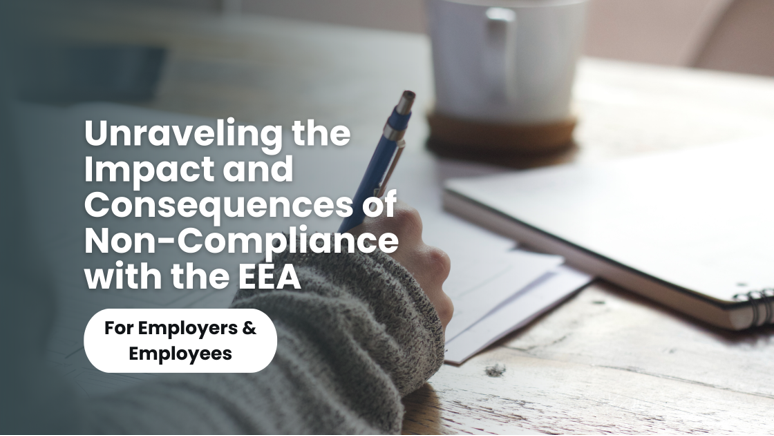
Employment Equity Act
14 July, 2023
Patron Career Staffing firmly believes in adopting a tailored approach to meet temporary and permanent recruitment needs. We safeguard the interest of our clients by finding such workers who are knowledgeable and reliable.
About UsNeed help? Make a Call
32 Dundas Street East Unit A, L5A1W2

Today’s article focuses on exploring the Employment Equity Act of Canada. This groundbreaking legislation is designed to promote equality in the workplace and eliminate systemic barriers faced by designated groups- women, Indigenous people, persons with disabilities, and visible minorities. Join us as we discuss the objectives behind the formation of the act, its impact on both employers and employees and the consequences of non-compliance. We shall also delve into the far-reaching effects of this act, and how it drives positive change in Canadian workplaces.
We have you covered in case you want to understand the basics of the EEA, whether as an employer who wants to stay compliant or an employee who wants to know their workplace rights. Click here to learn more.
The Goals of the Employment Equity Act
The EEA encompasses several main objectives that shape its purpose, implementation and help foster equality in the workspace.
1. Redressing Historical Disadvantages
The EEA claims to address historical disadvantages confronted by the underrepresented groups, including aboriginal people, women, visible minorities and persons with disabilities. By breaking down barriers, the act shall provide a level playing field for all groups and promote equal opportunities as well.
2. Promoting Diversity and Inclusion
The act recognizes the value of diversity and inclusion in the workplace. It aims to create environments where individuals from all backgrounds can contribute their unique talents and perspectives, fostering creativity and innovation.
3. Nurturing Equal Opportunities
The act strives to ensure that employment opportunities and advancement are available to all individuals, irrespective of their gender, ethnicity, disability, or other protected characteristics.
Related: Salient Features of the EEA

Impact on Employers and Employees
On the facade of the Employment Equity Act, we find how its provisions touch upon employers and employees.
1. Employers
The act places certain obligations on employers, such as developing and implementing employment equity plans, conducting workforce analysis, and reporting annually to the government. Employers are required to take hands-on measures to remove barriers in recruitment and hiring, implement fair employment practices, and provide reasonable accommodations for persons with disabilities. Complying with the act not only helps organizations adhere to legal requirements but also fosters a positive corporate image, attracts top talent, and enhances employee engagement and productivity.
2. Employees
The EEA strives to create a fair and inclusive work environment where all employees have equal opportunities for employment and progression. It ensures that employees are treated equitably, irrespective of their designated group status. By promoting diversity and inclusion, the act encourages the recognition and appreciation of diverse perspectives, fostering a more harmonious and supportive workplace culture.
The Cost of Non-Compliance: Unveiling the Consequences
To get up to speed with the EEA, employers prioritize taking the initial step which is to create an employment equity plan. This helps them to stay compliant with the act by laying down specific policies and procedures for attracting, hiring and retaining talent. But businesses lacking in compliance requirements may not fare well amongst their competitors and the Canadian Human Rights Commission. Let’s look at some of the consequences for non-compliant employers:

1. Legal Ramifications
Employers who fail to comply with the act may face legal consequences, including investigations, fines, and penalties. The Canadian Human Rights Commission has the authority to investigate complaints related to employment equity and take appropriate actions against non-compliant employers.
2. Damage to Reputation
Non-compliance can damage an organization's goodwill both internally and externally. It may be seen as a lack of commitment to equality and diversity, affecting employee morale and trust. It can also deter potential job seekers, clients, and partners who prioritize organizations that prioritize inclusivity. Society may look down on your business eventually.
3. Missed Opportunities
Organizations that do not actively endorse employment equity miss out on the benefits of diversity and inclusion. By overlooking qualified individuals from designated groups, they may lose valuable talent and perspectives, limiting their potential for growth, innovation, and competitiveness.
Conclusion
The Employment Equity Act of Canada has comprehensive objectives that aim to foster workplace equality, diversity, and inclusion. It impacts employers by requiring proactive measures to address systemic barriers and ensure equal opportunities for all employees. For employees, the act promotes a fair and inclusive work environment, offering equal access to employment and advancement. Non-compliance with the act can result in legal consequences, reputational damage, and missed opportunities. By embracing the principles embedded in this act, employers can create more lively, productive, and harmonious workplaces that celebrate the diverse talents of the Canadian workforce.
